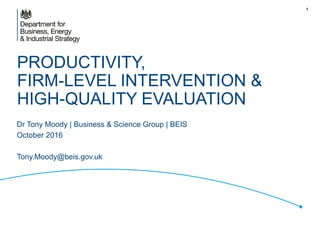
Productivity, firm-level intervention and high-quality evaluation
- 1. PRODUCTIVITY, FIRM-LEVEL INTERVENTION & HIGH-QUALITY EVALUATION Dr Tony Moody | Business & Science Group | BEIS October 2016 Tony.Moody@beis.gov.uk 1
- 2. Belief: UK Productivity is being held back by deficiencies in management and leadership capabilities. • Productivity decompositions attribute much of the productivity gap against G7 competitors to TFP, rather than labour quality or capital investment. Management & leadership capability would appear in TFP. • International comparisons place the UK in mid-table for quality of its management and leadership. • Deficiencies in UK management skills are a key driver of the productivity gap • Bloom et al (2014) estimate that about a quarter of the UK’s productivity gap with the United States could be down to poor management • Recent research with the ERC has expanded analysis to SMEs in the UK and finds shows similar links between skills, practices and performance (lower diagram), and a ‘long tail’ of firms with room for improvement • UK Government invests extensively in improving workforce skills (schools, University, vocational quals). Likewise in improving capital markets, R&D, innovation. These are the ingredients of productivity. • But investment in how the ingredients are combined – the recipe and the culinary skills – in UK is low, suggesting potential for intervention to valuably improve how people and resources are used more effectively. How management skills and practices lead to improved outcomes Source: Constraints on Developing UK Management Practices, BIS 2011 Source: BIS (2015) Leadership and management skills in small and medium-sized businesses. Average management and leadership scores by country, ranked from low to high 2
- 3. Hypothesis: Business-Level intervention can Improve Whole Economy Productivity • Adding fertiliser to a plant to improve the ecology of a habitat. • …Yet, so many processes between intervention and impact, and spanning big differences in scale ? 3
- 4. Where to start?! Remains extremely difficult to pick future HGFs • Predicting future high-growth prone to Type I & Type II errors • Only know the characteristics that improve the chances of future high growth: • E.g. capabilities of owner/managers, level of ambition, market opportunities. • …but often unobservable and even then hardly high precision. • If hard to pick winning businesses, even harder to pick proven winning policy interventions! 4
- 5. Logic Model with Huge Black Box Economy-level impacts Displacement (factor market and/or product market)? Firm-level impacts Perceptions or business metrics Proxies for productivity. Intervention Selection effects? Purity of treatment Firm to receive intervention Productivity Impact? 5
- 6. There is scarce robust evidence to measure impacts or improve design • Evaluations typically focus on the beneficiaries’ assessment of benefits and a single policy design • This approach does not provide a robust assessment • The UK What Works Centre conducted a review of impact evaluations from across the OECD • Just 1% provided credible evidence of growth impacts Area Evaluations Reviewed Robust approach Growth impacts identified Business Advice 730 23 14 Access to Finance 1450 27 17 Innovation 1700 63 9 6
- 7. Randomised Control Trials (RCTs) of business advice in BEIS • Using RCTs to address specific questions in our hypothetical causal chain. • If one link in the circuit doesn’t work, then whole black box won’t work. • Four RCTs on Business Advice: - Main Growth Vouchers Programme (GVP) - Growth Vouchers Additional Target group - Business Schools RCT - Growth Impact Pilot RCT 7
- 8. Growth Vouchers Programme - An example of a large scale trial • UK launched the Growth Vouchers Programme as a research trial testing the benefits of supporting businesses to use external strategic advice • Between Jan 2014 and March 2015: • 38,000 applications • 28,000 diagnostics • 20,000 vouchers issued, worth up to £39.4 million • 6,400 vouchers used, £11m claimed • RCT implemented successfully 8
- 9. Growth Vouchers Programme – Early Evidence • Subsidising cost of Business Advice led to increased use of advice in treatment group (no evidence of substitution). • Positive initial perception evidence from treatment group in terms of future business actions needed for growth. • But too early for business performance metrics (and take a long time to measure in admin data because of reporting lags). • There might be an adverse impact on self-assessment of business skills within treatment as they are exposed to what they don’t know, and consider focus (tackling ‘how’, not ‘what’). 9
- 10. Emerging lessons from wider BEIS evaluation • Can’t pick likely future winners from data. We cannot identify future HGFs from standard business data on current and past characteristics (e.g. growth trajectories, size, age, sector, geography). • …yet businesses receiving intervention grow quicker. Businesses participating on GrowthAccelerator (part of Business Growth Service) grew 3x faster than peers – so something going on – either successful selection based on richer data (inc. soft data), or an indicator of intervention impacts. • Perception data from managers may not align to business performance. • How businesses act on advice varies. We don’t know what changed behaviour will produce the most improvement. • Time lags. Our wider evaluation evidence suggests that impacts on business metrics might take 3-5 years to reach full effect – just as many evaluations stop listening. 10
- 11. Many Questions remain unanswered We don’t know: • Improvement in SME-level productivity. [We measure turnover/jobs, not GVA] • Improvement in wider economy productivity. But suspect: • Rather than measure productivity directly, past interventions seek to minimise substitution or displacement through eligibility and targeting. • Return of investment unlikely to be scalable to offer impacts measureable at economy-wide level. • …but they are likely to be a helpful investment with a speedy return because they engage currently economically active and ambitious businesses. 11
- 12. PRODUCTIVITY, FIRM-LEVEL INTERVENTION & HIGH-QUALITY EVALUATION Dr Tony Moody | Business & Science Group | BEIS October 2016 Tony.Moody@beis.gov.uk Our research, evaluations and surveys are published here: https://www.gov.uk/government/collections/enterprise-analysis-research 12
